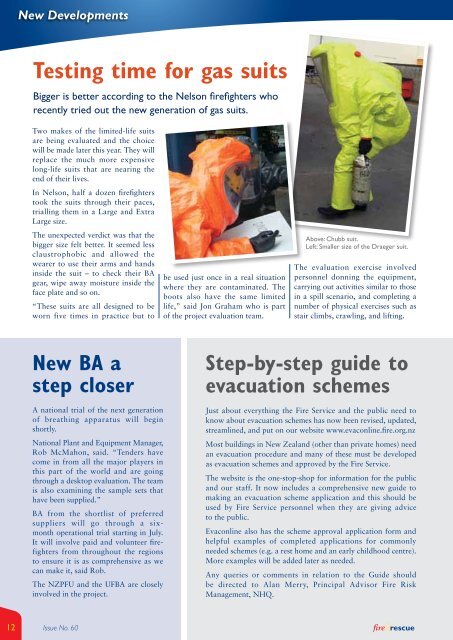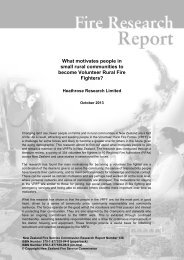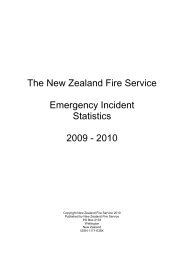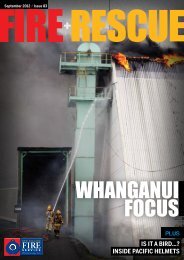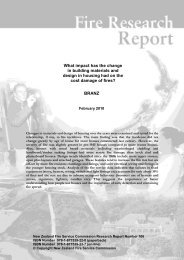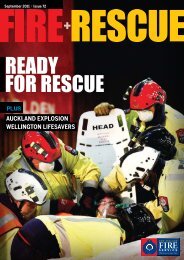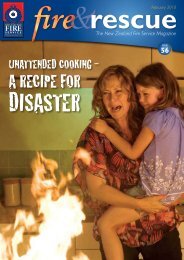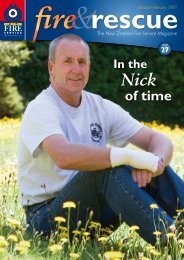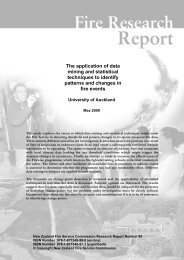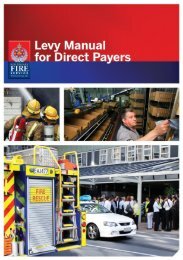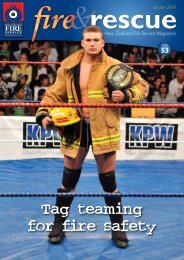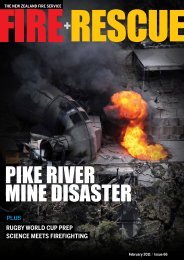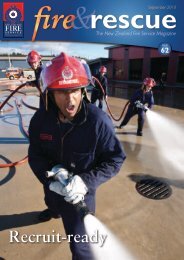Download - New Zealand Fire Service
Download - New Zealand Fire Service
Download - New Zealand Fire Service
You also want an ePaper? Increase the reach of your titles
YUMPU automatically turns print PDFs into web optimized ePapers that Google loves.
<strong>New</strong> Developments<br />
Testing time for gas suits<br />
Bigger is better according to the Nelson firefighters who<br />
recently tried out the new generation of gas suits.<br />
Two makes of the limited-life suits<br />
are being evaluated and the choice<br />
will be made later this year. They will<br />
replace the much more expensive<br />
long-life suits that are nearing the<br />
end of their lives.<br />
In Nelson, half a dozen firefighters<br />
took the suits through their paces,<br />
trialling them in a Large and Extra<br />
Large size.<br />
The unexpected verdict was that the<br />
bigger size felt better. It seemed less<br />
claustrophobic and allowed the<br />
wearer to use their arms and hands<br />
inside the suit – to check their BA<br />
gear, wipe away moisture inside the<br />
face plate and so on.<br />
“These suits are all designed to be<br />
worn five times in practice but to<br />
<strong>New</strong> BA a<br />
step closer<br />
A national trial of the next generation<br />
of breathing apparatus will begin<br />
shortly.<br />
National Plant and Equipment Manager,<br />
Rob McMahon, said. “Tenders have<br />
come in from all the major players in<br />
this part of the world and are going<br />
through a desktop evaluation. The team<br />
is also examining the sample sets that<br />
have been supplied.”<br />
BA from the shortlist of preferred<br />
suppliers will go through a six-<br />
month operational trial starting in July.<br />
It will involve paid and volunteer firefighters<br />
from throughout the regions<br />
to ensure it is as comprehensive as we<br />
can make it, said Rob.<br />
The NZPFU and the UFBA are closely<br />
involved in the project.<br />
12 Issue No. 60<br />
be used just once in a real situation<br />
where they are contaminated. The<br />
boots also have the same limited<br />
life,” said Jon Graham who is part<br />
of the project evaluation team.<br />
Above: Chubb suit.<br />
Left: Smaller size of the Draeger suit.<br />
The evaluation exercise involved<br />
personnel donning the equipment,<br />
carrying out activities similar to those<br />
in a spill scenario, and completing a<br />
number of physical exercises such as<br />
stair climbs, crawling, and lifting.<br />
Step-by-step guide to<br />
evacuation schemes<br />
Just about everything the <strong>Fire</strong> <strong>Service</strong> and the public need to<br />
know about evacuation schemes has now been revised, updated,<br />
streamlined, and put on our website www.evaconline.fire.org.nz<br />
Most buildings in <strong>New</strong> <strong>Zealand</strong> (other than private homes) need<br />
an evacuation procedure and many of these must be developed<br />
as evacuation schemes and approved by the <strong>Fire</strong> <strong>Service</strong>.<br />
The website is the one-stop-shop for information for the public<br />
and our staff. It now includes a comprehensive new guide to<br />
making an evacuation scheme application and this should be<br />
used by <strong>Fire</strong> <strong>Service</strong> personnel when they are giving advice<br />
to the public.<br />
Evaconline also has the scheme approval application form and<br />
helpful examples of completed applications for commonly<br />
needed schemes (e.g. a rest home and an early childhood centre).<br />
More examples will be added later as needed.<br />
Any queries or comments in relation to the Guide should<br />
be directed to Alan Merry, Principal Advisor <strong>Fire</strong> Risk<br />
Management, NHQ.


